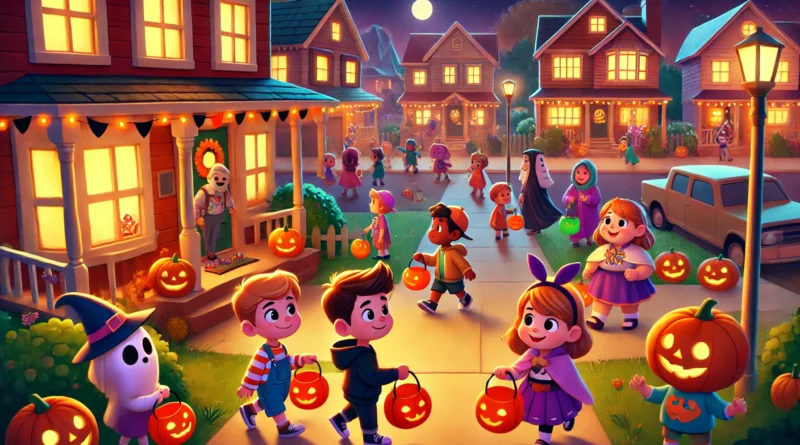Is It Fair Play? The Ups and Downs of Trick-or-Treating Beyond Your Own Block
As Halloween approaches, a growing trend has sparked debates in communities across the U.S.—neighborhood hopping for trick-or-treating. Many families venture out of their own neighborhoods to seek out areas known for generous candy hauls, festive decorations, and safer streets. But is this practice a win-win for all? Here’s a closer look at the pros and cons for both the neighborhood residents and the visiting trick-or-treaters.
The Pros for Trick-or-Treaters
- Better Candy and More Fun:
- Some neighborhoods are known for going all out on Halloween, with impressive decorations and a tradition of giving out high-quality candy. Families may choose to visit these areas for a more exciting trick-or-treating experience that includes full-sized candy bars, interactive decor, and even haunted house setups.
- Safety in Numbers:
- Parents may prefer neighborhood hopping for safety reasons. More affluent areas may have better lighting, wider streets, and less traffic, providing a safer environment for kids to roam. Additionally, these neighborhoods often have an organized trick-or-treating atmosphere with more adults supervising, reducing risks.
- Longer Trick-or-Treating Routes:
- Some families live in rural or sparsely populated areas where trick-or-treating isn’t practical due to distance between homes or lack of participation. By visiting another neighborhood, kids can make the most of their Halloween and cover more ground in a shorter time.
The Cons for Trick-or-Treaters
- Crowds and Competition:
- Popular trick-or-treating neighborhoods can get overcrowded. Too many visitors may mean long lines at houses or even running out of candy. The festive atmosphere can become more chaotic, and children might not get the fun, personal experience they hoped for.
- Travel and Parking Issues:
- Families often need to drive to these neighborhoods, leading to parking difficulties or unsafe traffic conditions. Parents have to find parking in unfamiliar areas, and cars crowd the streets, which could cause delays or even accidents.
- Neighborhood Pushback:
- In some cases, local residents might express resentment toward outsiders, especially when the influx of visitors becomes overwhelming. Trick-or-treaters may feel unwelcome, and the experience could be less enjoyable as a result.
The Pros for Neighborhood Residents
- A More Lively Halloween:
- For residents in popular trick-or-treating areas, having a steady flow of visitors can bring a fun, community-wide atmosphere. Some homeowners take pride in making their homes the “place to be” on Halloween, enjoying the excitement that comes with large groups of trick-or-treaters.
- Building a Sense of Community:
- Welcoming families from other areas can foster a sense of inclusivity and community spirit. Halloween becomes a chance to unite people from different neighborhoods, especially those from areas where trick-or-treating may not be practical.
The Cons for Neighborhood Residents
- Running Out of Candy:
- One of the most common complaints from residents in high-traffic areas is the sheer volume of visitors, which often leads to running out of candy early in the evening. Residents who want to participate may need to buy a significant amount of candy, which can become costly.
- Increased Traffic and Safety Concerns:
- With the influx of visitors, streets can become congested with cars and people. This can pose safety risks, especially for small children, and create traffic issues in typically quiet neighborhoods. Homeowners may also worry about litter, property damage, or increased noise levels.
- Exclusivity and Unequal Access:
- Some residents feel that neighborhood hopping disrupts the idea of Halloween being a local event for kids who live in the community. Others argue that it creates inequality, where wealthier neighborhoods become the default destination for “better” Halloween experiences, leaving poorer areas with little participation.
A Balancing Act for Halloween Fun
Neighborhood hopping for trick-or-treating is a complex issue with valid points on both sides. For trick-or-treaters, it offers the chance for a better, safer experience. However, for residents, it can bring challenges, from candy shortages to safety concerns. Ultimately, the practice reflects a broader conversation about community, fairness, and how to ensure that Halloween remains fun for everyone.
Perhaps the best approach is for neighborhoods to welcome visitors but also set boundaries that ensure safety and enjoyment for all. For families, being mindful of the residents they visit—by being respectful, courteous, and not overstaying their welcome—can go a long way in keeping the Halloween spirit alive.




